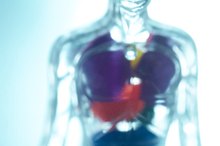Bruised Kidney Symptoms
Although the kidneys occupy a protected area toward the back of the abdomen, these vital organs remain subject to traumatic injury. Motor vehicle accidents, falls, and other high-force trauma to the abdomen or back can cause kidney injury. A significant blow may cause a kidney bruise, an injury characterized by bleeding within the kidney. Recognizing the symptoms of a bruised kidney can aid in the diagnosis and early treatment of this serious injury.
Abdominal or Flank Pain
Abdominal pain commonly occurs with a bruised kidney. Because a kidney injury often occurs along with other traumatic abdominal injuries, there may be pain throughout the abdomen. For example, liver and spleen injuries frequently accompany traumatic kidney injuries. In cases of isolated kidney injury, there is often pain in the flank area, between the upper edge of the hip and the lower rib cage. Skin bruising over the back or abdomen and seat belt marks across the body indicate a high-force injury, which raises the level of suspicion for a possible kidney injury.
- Abdominal pain commonly occurs with a bruised kidney.
- In cases of isolated kidney injury, there is often pain in the flank area, between the upper edge of the hip and the lower rib cage.
Abdominal or Flank Tenderness
Lacerated Kidney Symptoms
Learn More
People with a bruised kidney may exhibit abdominal or flank tenderness on physical examination. Diagnostic imaging tests, such as a CT scan of the abdomen and an abdominal ultrasound, often prove necessary in people with a traumatic abdominal injury. Imaging tests reveal damage to the various organs and the extent of each injury. According to the American Association for the Surgery of Trauma kidney injury scale, kidney bruising represents a grade I or grade II injury 2. On CT scan, kidney bruising appears as a collection of blood -- a hematoma -- within the kidney or surrounding the organ.
- People with a bruised kidney may exhibit abdominal or flank tenderness on physical examination.
- On CT scan, kidney bruising appears as a collection of blood -- a hematoma -- within the kidney or surrounding the organ.
Blood in the Urine
Blood in the urine is an important and reliable indicator of blunt kidney injury. Large amounts of blood cause red to brown urine coloration. Smaller amounts of blood typically lead to a noticeable pink tinge to the urine. In some cases, blood in the urine may be detectable only through use of laboratory testing. Bleeding within the kidney may also lead to the passage of small blood clots in the urine. Although a kidney bruise is the least severe form of kidney trauma, it is a serious injury 2. Treatment involves strict bed rest until kidney bleeding resolves, as evidenced by the absence of blood in the urine.
- Blood in the urine is an important and reliable indicator of blunt kidney injury.
- Bleeding within the kidney may also lead to the passage of small blood clots in the urine.
Medical Care
Symptoms of a Bruised Bladder
Learn More
Anyone who has been involved in a significant accident or fall, or has sustained a high-force blow to the flank requires medical evaluation. Kidney injuries as well as other abdominal injuries may not cause immediate symptoms but can quickly evolve. Kidney bruises often heal without causing permanent damage, but medical monitoring is necessary to ensure a complication does not develop.
Reviewed by: Tina M. St. John, M.D.
- Anyone who has been involved in a significant accident or fall, or has sustained a high-force blow to the flank requires medical evaluation.
- Kidney bruises often heal without causing permanent damage, but medical monitoring is necessary to ensure a complication does not develop.
Related Articles
References
- Merck Manual Professional Version: Renal Trauma
- Singapore Medical Journal: Computed Tomography of Blunt Renal Trauma
- Shoobridge JJ, Corcoran NM, Martin KA, Koukounaras J, Royce PL, Bultitude MF. Contemporary management of renal trauma. Rev Urol. 2011;13(2):65-72.
- Haller JA, Papa P, Drugas G, Colombani P. Nonoperative management of solid organ injuries in children. Is it safe?. Ann Surg. 1994;219(6):625-8; discussion 628-31.
- Malaeb B, Figler B, Wessells H, Voelzke BB. Should blunt segmental vascular renal injuries be considered an American Association for the Surgery of Trauma Grade 4 renal injury?. J Trauma Acute Care Surg. 2014;76(2):484-7. DOI: 10.1097/TA.0b013e3182aa2db4
- Shoobridge JJ, Corcoran NM, Martin KA, Koukounaras J, Royce PL, Bultitude MF. Contemporary management of renal trauma. Rev Urol. 2011;13(2):65-72.
- van Hensbroek PB, van Ooijen M, Lamers AB, Ponsen KJ, Goslings JC. Abdominal injuries after high falls: high incidence and increased mortality. Acta Chir Belg. 2013 May-Jun;113(3):170-4.
- Wendler JJ, Jürgens J, Schostak M, Liehr UB. Traumatically shattered kidney without urine extravasation or vascular amputation. BMJ Case Rep. 2015. DOI:10.1136/bcr-2014-208303
Writer Bio
Dr. Tina M. St. John owns and operates a health communications and consulting firm. She is also an accomplished medical writer and editor, and was formerly a senior medical officer with the U.S. Centers for Disease Control and Prevention. St. John holds an M.D. from Emory University School of Medicine.







